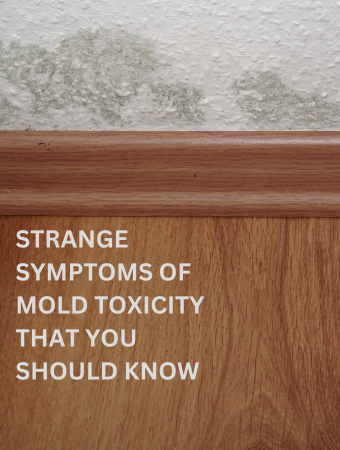
Toxic mold exposure is more common than people think. According to data from the EPA’s Building Assessment Survey and Evaluation Study (BASE), 85% of commercial buildings in America show signs of previous water damage. Of the buildings assessed during that survey, 45% had ongoing, active water intrusion. This study went on to note that 70% of all construction lawsuits revolve around water damage of some type. And all of those numbers just represent potential commercial exposure. Another study, from the Occupational Safety and Health Administration (OSHA), estimates that 25% of the homes in America are water damaged buildings. Given that potential exposure is nearly everywhere, these are the strange symptoms of mold toxicity that you should know.
COMMONLY ACCEPTED SYMPTOMS OF TOXIC MOLD EXPOSURE
When we finally realized that the root cause of my long illness was toxic mold exposure, I was relieved to have an answer. My body had been rapidly deteriorating for more than three years. As we shared this news with others, we were met with some disbelief and denial. We heard:
“But you don’t have respiratory symptoms.”
“Toxic mold only affects the lungs.”
“Mold can’t do that to your body.”
The truth is, there are commonly accepted symptoms of toxic mold exposure, and then there are other symptoms which are considered “strange.” Much of western medicine dismisses many of the lesser known symptoms. But let’s begin with the symptoms that are widely recognized. Here are the more commonly accepted symptoms of toxic mold exposure:
- Sneezing
- Coughing
- Nasal Congestion
- Post-Nasal Drip
- Red Eyes
- Wheezing
- Shortness of Breath
- Dry Cough
- Chest Tightness


LESSER KNOWN SYMPTOMS OF LONG TERM TOXIC MOLD EXPOSURE
My family unknowingly lived in toxic mold for five years. Our house was old. It had a musty smell. We just assumed that it was an “old house smell.” We were wrong. The house harbored a dangerous amount of toxic mold in the basement and in the walls. Here is a list of the lesser known symptoms of long term toxic mold exposure:
- Abdominal Pain, Bloating, and Diarrhea
- Weight Gain
- Hair Loss
- Joint Pain
- Muscle Cramps
- Lightheadedness
- Sensitivity to Light
- Tingling and Numbness in the Hands and Feet
- Chronic Disease
While I did not personally experience respiratory symptoms from toxic mold exposure, I did experience every one of these “lesser known” symptoms of mold toxicity. Regarding chronic disease, I was diagnosed with a new autoimmune disease or related condition every three months for three years. My body was crying out for help, and for a time, we didn’t know why. I saw more than twenty physicians. No one could put the pieces together.
POSSIBLE NEUROLOGIC SYMPTOMS OF TOXIC MOLD EXPOSURE
Aside from all of the symptoms listed in the section above, I also experienced neurologic symptoms. In all honesty, they were my first symptoms. They were so diverse and seemed so unrelated. At times, I didn’t even know how to rightly explain what I was experiencing. My personal list of neurologic symptoms looked something like this:
- Fatigue
- Brain Fog
- Forgetfulness
- Difficulty Concentrating
- Difficulty Making Decisions
- Anxiety
- Inability to Find Words When Speaking
- Loss of Reading Comprehension
- Headaches/Migraines
- Anger/Rage
- Blurred Vision
I saw many western medicine doctors who could not piece these symptoms together into a diagnosis. At first, they thought I had a brain tumor. Then they thought these were side effects of being hypothyroid. Beyond that, once we ruled out a brain tumor and brought my thyroid back into balance, they simply ignored these symptoms because they could not be explained. (They were quick to offer me an anti-depressant, but I wasn’t interested in that.) I wish that more medical professionals were familiar with these symptoms as a possible outcome of toxic mold exposure.
MY HOPE FOR THE FUTURE
I believe that if more people know the symptoms of toxic mold exposure, intervention will be quicker and more widely accepted. As it is, most people I know who have healed from toxic mold exposure have healed outside of the western medical system. But there is hope for healing. Mold avoidance is the first step. Beyond that, one should support the body’s natural detox pathways. The body is designed to heal. My hope is that these strange symptoms of mold toxicity will one day be widely recognized so that no one is undiagnosed (or misdiagnosed) for years on end.


To read more about my journey to recover from mold toxicity, see How I Healed My Brain and What I Learned About Myself.





